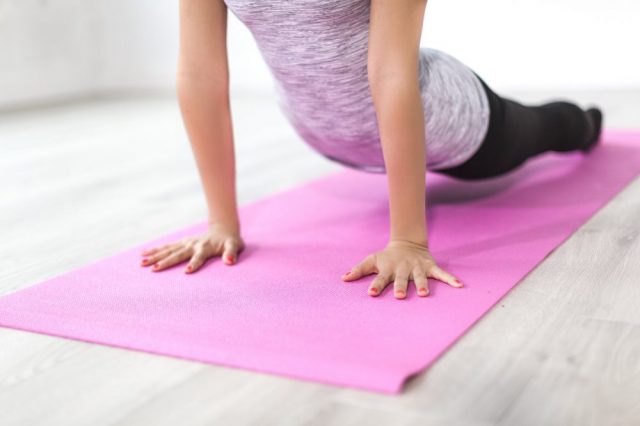19 Quirky Ideas to Fit More Physical Activity into Your Busy Day

This article is written by Anita Fernandes.
Chronic illness is often associated with long-term discomfort and pain. This long term pain can change a person’s mood and disposition and increase their risk of anxiety and depression. Exercise is one of the simplest ways to improve your quality of life if you suffer from a chronic illness. This is because exercise not only strengthens the body but also improves mood. Having a chronic illness does not necessarily mean that you need to lead a sedentary lifestyle – in fact, you will benefit more from daily exercise than most people.
Take a look at these 7 tips to stay fit when you have a chronic illness.
Chronic conditions are often associated with chronic pain which may have prevented you from exercising in the past. When starting a new fitness routine, start slow as this will give your muscles time to slowly adjust to your workout. This will lower the risk of injury and pain. Start with something as simple as a 5-min walk each morning and evening. After a couple of weeks, you can increase this to 10 minutes a day. Once you are comfortable in your new routine, add range-of-motion exercises such as shoulder rotations, arm lifts and leg lifts to your exercise plan.
You’ve probably heard of the ‘no pain, no gain’ rule – this certainly does not apply to you! When you have a chronic illness, your body is already under a considerable amount of stress, so your exercise routine should focus on getting healthy and fit but at a slower pace. If you suffer from a chronic condition such as arthritis or osteoporosis, you can start with swimming or water aerobics as this will take the pressure off your joints. Similarly, people with chronic obstructive pulmonary disease (COPD) can benefit from aerobic exercises such as using a stationary cycle. Studies show that 92% of COPD patients reported an increase in daily activity after 18 weeks of using a stationary cycle.
When you decide to start a new fitness routine, you might be tempted to follow a fixed workout plan. This is a bad idea! Pushing yourself beyond your limits could result in injury which could lead to you giving up on your fitness plans. Set your own pace by listening to your body and accepting that you may need to go at a slower pace than other people but that you will reach your fitness goals as long as you stick to your daily exercise routine. Remind yourself that even a small increase in daily activity will result in big improvements over time.
Experts recommend that we get at least 150 minutes of moderate-intensity aerobic physical activity each week. This means that you would need 25 minutes of moderate-intensity exercise each day for 6 days a week. You can break this up into 2 sessions of 12.5 minutes each as this will put less stress on your system. People who suffer from chronic heart conditions including high blood pressure and arrhythmia (abnormal heart rhythms) will benefit from shorter workout sessions, as it does not place too much stress on the cardiovascular system.

Many people feel motivated to exercise because they want six-pack abs, but don’t make this mistake. Aim to get healthy and fit – the visible results are just the bonus and not the goal! When you have a chronic condition, being fit and healthy will lower your risk of health complications and improve your quality of life. Studies show that people who have a healthy body weight but lead a sedentary lifestyle are at a higher risk for health problems as compared to overweight individuals who exercise.
Aerobic exercise (cardio) is becoming increasingly popular as several recent studies revealed that it offers a wide range of health benefits from improving cardiovascular health to reducing chronic pain and strengthening the immune system. Studies also show that aerobic exercise is particularly beneficial for people with chronic illnesses. For instance, researchers found that just 1 week of aerobic training can improve insulin sensitivity in diabetes patients.
Similarly, researchers found that arthritis patients who engaged in aerobic training experienced improved muscle strength and decreased joint pain. Low-impact aerobic exercise such as swimming or riding a stationary bike will help to improve your health and fitness levels with minimal stress on your body.
It is important to exercise and get fit but when you have a chronic illness, you need to take steps to safeguard your health. For example, if you have diabetes, you might need to check your blood sugar level before you start your workout since physical activity lowers blood sugar. Similarly, if you have arthritis, osteoporosis or any other chronic condition that affects your joints, you can have a warm shower before your workout as the heat will help to relieve your muscle and joint pain and relax your muscles.
Exercise can help to treat physical health issues such as cardiovascular disease as well as mental health issues such as Parkinson’s and Alzheimer’s. If you suffer from any of these mental health issues, make sure that you talk to your doctor before you start any exercise routine. People with chronic illnesses often think that exercising will increase their discomfort and pain, but studies show that regular physical activity can help to reduce chronic disease pain.
Author bio: Anita Fernandes is a journalist and a writer by profession. She has been writing extensively on health and wellness related topics for a little over a decade now. Besides her professional interests, she loves a game of basketball or a good hike in her free time to fuel her spirits. “Health is wealth” is one motto of life which she lives by as well as advocates to every reader, who comes across her blogs.
If you enjoyed reading this article, you might also like: